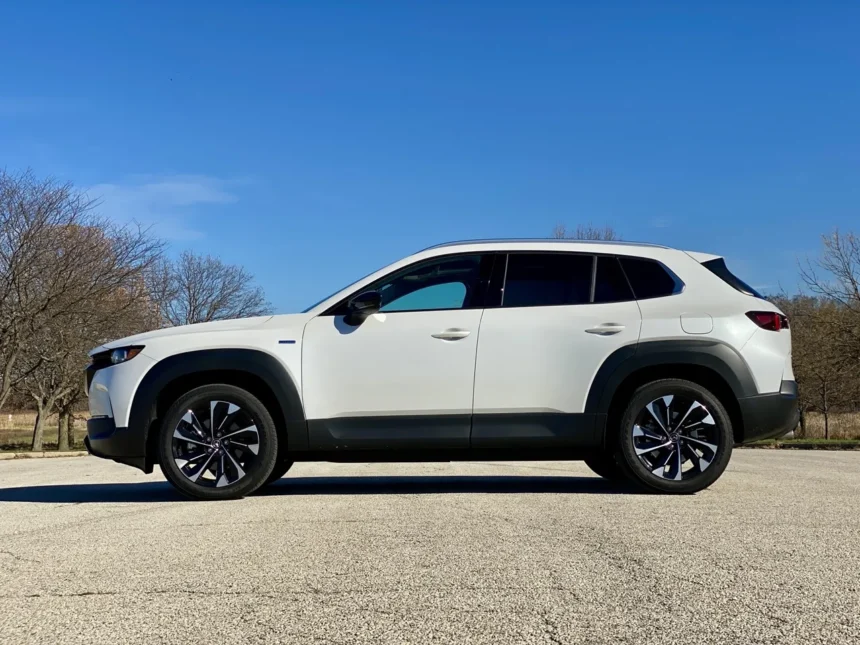The battle for supremacy in the compact crossover segment continues to heat up with the introduction of the 2025 Honda CR-V and the 2025 Mazda CX-50. Both of these vehicles are aiming to dethrone the long-standing bestseller, the Toyota RAV4, with their strong hybrid offerings and impressive features.
One of the biggest developments this year is the rise of the Honda CR-V Hybrid, which now accounts for more than half of CR-V sales. On the other hand, Mazda has entered the hybrid market with its first hybrid CX-50, sourced from the Toyota RAV4. With fierce competition from Toyota, Honda, and even Hyundai with the Tucson Hybrid, Mazda’s CX-50 may need to focus on meeting emissions compliance more than satisfying market demand.
In terms of pricing and trims, the Mazda CX-50 starts at $32,000 and goes up to nearly $45,000, with standard AWD. In comparison, the Honda CR-V starts at $31,000 and goes above $42,000 for the Sport Touring trim. Both hybrid models start at nearly $36,000, with the best picks being the CX-50 Hybrid Preferred and the CR-V Hybrid Sport.
When it comes to features and options, Mazda offers more choices for its CX-50, spanning a wide price range and trim levels. The CX-50 comes with standard all-wheel drive, giving it an advantage over the CR-V. Both models offer good driver-assist tech, cloth upholstery, smartphone compatibility, and a 3-year/36,000-mile basic warranty. However, the CX-50’s infotainment system may require more steps to complete simple tasks compared to the CR-V’s more straightforward interface.
In terms of performance and specs, the Mazda CX-50 offers a 2.5-liter inline-4 engine that makes 187 hp and 186 lb-ft of torque. The CX-50 Turbo models use a 2.5-liter turbo-4 engine that produces 227 hp and 310 lb-ft of torque. On the other hand, the Honda CR-V is equipped with a 1.5-liter turbo-4 engine that delivers 190 hp and 179 lb-ft of torque. The CR-V Hybrid Sport models make 204 hp and 247 lb-ft, while the Mazda CX-50 Hybrid matches the Toyota RAV4 with 219 hp and 163 lb-ft of torque.
In terms of driving experience, the Mazda CX-50 excels in handling and steering, with all-wheel drive coming standard on every model. The CX-50 Hybrid may be a bit loud when pushed, but its excellent steering and poised handling make up for it. The CX-50’s 2.5-liter turbo-4 engine provides a sportier ride, but it may lag from a stop. Overall, the CX-50 offers a comfortable and enjoyable driving experience, with the Hybrid model taking around eight seconds to reach 60 mph.
In conclusion, both the 2025 Honda CR-V and the 2025 Mazda CX-50 offer strong competition in the compact crossover segment. While the CR-V may have the edge in terms of value and performance, the CX-50 stands out with its unique design and upscale interior. Shoppers looking for a reliable and efficient hybrid crossover will find both of these vehicles to be compelling options in the market.
When it comes to driving, the Honda CR-V offers a smooth and efficient ride. The CR-V hybrids are designated as Sport trims, but they prioritize efficiency over power. The Sport trim models marry a 2.0-liter 4-cylinder engine running on the Atkinson cycle with a pair of electric motors. The 1.4-kwh battery pack feeds the motors for electric drive at low speeds, making it relatively quiet in Eco and Normal modes. The engine starts up as a generator under heavier acceleration, but it remains unnoticeable. The CR-V handles with more bounding and leaning compared to the CX-50, but it feels more connected to the road than the standard CR-V.
On the other hand, the non-hybrid CR-Vs come with a 1.5-liter turbo-4 engine that offers slightly quicker acceleration without the lag seen in the CX-50 Turbo. The CR-V’s CVT may make the engine whine when pushed hard, but it remains predictable and quiet during everyday driving.
Overall, the advantage in terms of power goes to the CX-50 Turbo, while the CR-V Hybrid excels in other aspects of driving experience.
Fuel Economy Comparison
- CR-V turbo-4: 28 mpg city, 34 highway, 30 combined (AWD loses 1 mpg)
- CR-V Hybrid: 43/36/40 mpg (FWD) and 40/34/37 mpg (AWD)
- CX-50 Hybrid: 38 mpg combined
- CX-50 2.5-liter: 25/31/28 mpg (AWD)
- CX-50 Turbo: 23/29/25 mpg (AWD)
The Honda CR-V Hybrid outperforms the CX-50 in terms of fuel economy, making it a more efficient choice for those looking to save on gas costs.
Size and Specifications
- CX-50 is larger than the Mazda CX-5 and the CR-V, yet the CR-V is roomier
- CR-V offers more cargo space (39.2 cubic feet) compared to the CX-50 (31.4 cubic feet)
- CR-V provides more rear legroom (41 inches) than the CX-50 (39.8 inches)
- CR-V hybrid battery pack is located beneath the cargo floor, maintaining cargo space
Both the Honda CR-V and the Mazda CX-50 can comfortably seat four adults, with the middle seat in the back suitable for occasional use. The CR-V may be slightly shorter in length compared to the CX-50, but it offers a wider and taller interior space, optimizing storage areas for everyday items. Additionally, the CR-V boasts more rear legroom and headroom, making it one of the most spacious vehicles in its class.
While the CX-50 may have more upscale finishes, including leather upholstery and stylish details, it falls short in terms of cargo and passenger space when compared to the CR-V.
In conclusion, both the Honda CR-V and the Mazda CX-50 have their own strengths and weaknesses when it comes to driving experience, fuel efficiency, and interior space. The CR-V Hybrid may lack in power compared to the CX-50 Turbo, but it excels in fuel economy and overall spaciousness. Ultimately, the choice between these two SUVs will depend on individual preferences and priorities.
The cargo volume of the Honda CR-V has shrunk, measuring at 31.4 cubic feet behind the rear seats and 56.3 cubic feet with the rear seats down. Despite this decrease in cargo space, the CR-V still holds its own in the compact SUV segment.
When it comes to safety, the Mazda CX-50 has earned the IIHS Top Safety Pick+ award, while the CR-V has dropped to a Top Safety Pick. Both models have received five-star overall ratings from the NHTSA and come equipped with automatic emergency braking, active lane control, and adaptive cruise control. However, the CX-50 has a slight edge with its standard blind-spot monitors and improved crash test ratings.
In terms of styling, the CX-50 adopts a rugged and bold design, while the CR-V combines various influences to create a unique look. The CX-50’s interior is more refined, with leather upholstery and tasteful accents, while the CR-V offers a mix of influences and a calm interior ambiance.
Overall, the Honda CR-V Hybrid comes out on top in this comparison. Its popularity in the hybrid segment, calmer ride quality, and overall rating of 7.0 out of 10 give it the edge over the Mazda CX-50, which scored a 6.7 out of 10. Both models have their strengths and weaknesses, but the CR-V Hybrid emerges as the winner in this matchup. In today’s fast-paced world, it’s becoming increasingly important to find ways to relax and unwind. One popular method that has been gaining popularity in recent years is mindfulness meditation. This ancient practice has been used for centuries to help individuals reduce stress, increase self-awareness, and improve their overall well-being.
Mindfulness meditation involves focusing on the present moment and observing thoughts, emotions, and sensations without judgment. By practicing mindfulness meditation regularly, individuals can learn to better manage their stress and anxiety, improve their concentration and focus, and enhance their overall sense of well-being.
One of the key benefits of mindfulness meditation is its ability to help individuals become more self-aware. By paying attention to their thoughts and emotions without judgment, individuals can gain a better understanding of themselves and their reactions to different situations. This increased self-awareness can lead to greater emotional intelligence and improved relationships with others.
In addition to improving self-awareness, mindfulness meditation can also help individuals reduce stress and anxiety. By focusing on the present moment and letting go of worries about the future or regrets about the past, individuals can experience a sense of calm and relaxation. This can have a positive impact on both mental and physical health, as chronic stress has been linked to a variety of health problems, including heart disease, high blood pressure, and depression.
Furthermore, mindfulness meditation has been shown to improve concentration and focus. By training the mind to focus on the present moment, individuals can enhance their ability to concentrate on tasks and stay focused for longer periods of time. This can be particularly beneficial in today’s world, where distractions are constantly vying for our attention.
Overall, mindfulness meditation is a powerful tool that can help individuals reduce stress, increase self-awareness, and improve their overall well-being. By incorporating mindfulness meditation into their daily routine, individuals can experience a greater sense of peace and fulfillment in their lives. So why not give it a try and see the positive impact it can have on your life?







